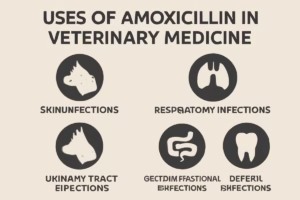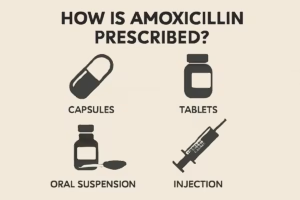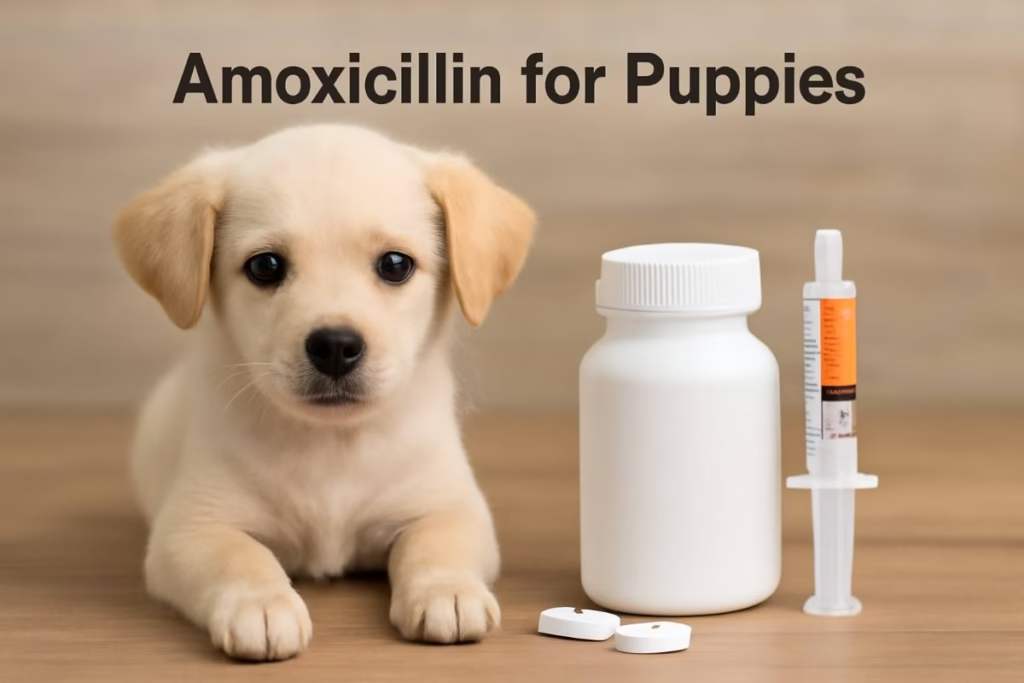When it comes to ensuring the health of our puppies, pet owners often encounter the need for medications that can help combat infections. One such commonly prescribed drug by veterinarians is amoxicillin. Whether your puppy has a bacterial infection in its skin, ears, or urinary tract, amoxicillin for puppies is often the go-to antibiotic to treat these issues effectively. This post will guide you through everything you need to know about amoxicillin for dogs, including dosage, potential side effects, and how to properly administer this antibiotic to your puppy.

What is Amoxicillin for Puppies?
Overview of Amoxicillin
Amoxicillin is an antibiotic in the penicillin class of medications. It is widely used in both human and veterinary medicine to treat bacterial infections. Its broad-spectrum activity allows it to target various bacterial infections that puppies can contract. Whether it’s a respiratory infection, a skin infection, or a urinary tract infection (UTI), amoxicillin for puppies is often one of the first-line treatments.
For more information on antibiotics and how they work in pets, check out this guide on antibiotics.
How Does Amoxicillin Work?
Amoxicillin works by inhibiting the formation of bacterial cell walls, which are essential for bacterial survival and multiplication. Without these cell walls, the bacteria are unable to thrive and eventually die off, which helps control the infection. In puppies, amoxicillin is commonly used to treat infections caused by bacteria like E. coli, Staphylococcus, and Streptococcus, among others.
Learn more about how antibiotics work in pets here.
Uses of Amoxicillin in Veterinary Medicine
Amoxicillin is effective for treating a range of infections in puppies, including:

-
Respiratory Infections: Puppies are more vulnerable to conditions like kennel cough and pneumonia, which often require antibiotic treatment.For more on treating canine respiratory infections, explore Zenquin for dogs.
-
Skin Infections: Puppies can get infected wounds, rashes, or abscesses, for which amoxicillin for dogs is often prescribed.For more on treating skin infections, see Simplicef 100mg for dogs.
-
Urinary Tract Infections: UTIs are common in puppies, and they can be very uncomfortable. Amoxicillin dosage for dogs helps eliminate the bacteria causing the infection.For more information on UTIs and treatment options, visit Cephalexin for cats.
-
Gastrointestinal Infections: Infections in the digestive tract can cause diarrhea, vomiting, and lack of appetite, which can often be treated with amoxicillin for puppies.
Why Would Your Puppy Need Amoxicillin?
Common Infections in Puppies
Puppies can face a variety of infections that require antibiotics like amoxicillin. These infections can be caused by bacteria that are commonly found in the environment, and they can significantly affect your puppy’s health if left untreated. Here are some of the reasons why your vet might recommend amoxicillin for puppies:

-
Respiratory Infections: Puppies are often exposed to other dogs in public spaces, shelters, and boarding facilities. This increases their risk of contracting respiratory infections such as kennel cough, pneumonia, or bronchitis, which are commonly treated with amoxicillin for puppies.
-
Urinary Tract Infections (UTIs): UTIs are a frequent cause of discomfort in puppies, leading to symptoms like frequent urination, blood in the urine, and even pain during urination. Amoxicillin for dogs is a standard treatment for UTIs in puppies.
-
Skin Infections: Whether due to allergies, minor wounds, or insect bites, puppies are prone to skin infections. If the infection is bacterial, amoxicillin for dogs can effectively treat it.
-
Gastrointestinal Problems: Bacterial infections can disrupt a puppy’s digestive system, leading to diarrhea and vomiting. Amoxicillin for puppies is prescribed to treat such gastrointestinal bacterial infections.
How is Amoxicillin Prescribed?
When a puppy shows symptoms of an infection, the veterinarian will examine the puppy thoroughly and, based on the symptoms, might suggest amoxicillin for puppies. The veterinarian will determine the proper dosage, treatment duration, and whether amoxicillin/clavulanate for dogs (a combination of amoxicillin and clavulanic acid) might be a better option depending on the severity and type of infection.

Correct Dosage of Amoxicillin for Puppies
How to Determine Amoxicillin Dosage for Dogs
The dosage of amoxicillin for dogs depends on several factors:
-
Weight: Amoxicillin dosage is typically calculated based on the puppy’s weight. The heavier the dog, the more amoxicillin they will need.
-
Age and Health: Puppies that are younger or have pre-existing conditions might need adjusted dosages.
-
Type of Infection: The dosage can also vary depending on whether the infection is mild or severe.
For accurate dosage charts, check out this doxycycline dosage guide.
For example, the amoxicillin 250 mg dosage for dogs is typically prescribed based on weight:
-
Small dogs (under 10 pounds) may need around 250 mg per dose every 12 hours.
-
Larger dogs (over 30 pounds) might need higher doses, up to 500 mg amoxicillin for dogs.
Amoxicillin Dosage for Dogs: Weight-Based Guidelines
Here’s a general amoxicillin dog dosage chart based on weight:
-
Under 10 pounds: 250 mg every 12 hours
-
10 to 20 pounds: 500 mg every 12 hours
-
21 to 30 pounds: 500 mg every 12 hours
-
Over 30 pounds: The dosage may increase depending on the severity of the infection
Ensure that the full course of antibiotics is completed, even if your puppy appears to be feeling better. This helps prevent the infection from returning and ensures that the bacteria are fully eradicated.
How to Administer Amoxicillin to Puppies
Forms of Amoxicillin for Puppies
Amoxicillin is available in several forms that cater to different needs:
-
Tablets: Amoxi tabs for dogs can be given directly to puppies or hidden in treats to make administration easier.
-
Liquid Suspension: Amoxi drops for cats can also be used for dogs in liquid form, making it easier to dose especially for smaller puppies.
-
Chewable Tablets: These are designed to be palatable for dogs and are easy to administer.
For further guidance on administering medication to your puppy, refer to Clavamox Dosage for Dogs.
How to Administer Amoxicillin to Your Puppy
Here’s a step-by-step guide to help you administer amoxicillin for puppies:
-
For Tablets: You can place the tablet in a pill pocket, or if your puppy is resistant, gently open their mouth and place the pill at the back of their throat, then immediately close their mouth and gently rub their throat to encourage swallowing.
-
For Liquid Suspension: Use a syringe or dropper to gently administer the liquid into the side of your puppy’s mouth.
-
Chewable Tablets: If your puppy enjoys the taste, you can offer them the chewable tablets as a treat.
Always ensure you’re using the right amount of medication as prescribed by your veterinarian. If you’re unsure about the proper method of administration, don’t hesitate to ask your vet for advice.
Side Effects and Risks of Amoxicillin for Puppies
Common Side Effects
While amoxicillin for puppies is generally safe, some puppies may experience side effects. The most common include:
-
Gastrointestinal upset: Vomiting, diarrhea, or loss of appetite are the most commonly reported side effects.
-
Allergic reactions: In rare cases, puppies may have allergic reactions that result in symptoms like swelling, difficulty breathing, or a rash.
For more information on potential risks and side effects, you can check out this article on Amoxicillin for dogs.
Severe Side Effects
-
Overdose: If your puppy consumes more amoxicillin than prescribed, they might show signs of lethargy, tremors, or confusion. In case of overdose, you should immediately contact your veterinarian.
-
Prolonged Use: Prolonged use of antibiotics can lead to antibiotic resistance. It is essential to complete the full course of treatment as prescribed.
When to Contact a Veterinarian
If your puppy experiences any of the following, you should contact your vet:
-
Persistent vomiting or diarrhea
-
Swelling or difficulty breathing (signs of an allergic reaction)
-
Lethargy or unusual behavior
-
Overdose symptoms (tremors, confusion)
Alternatives to Amoxicillin for Puppies
While amoxicillin for dogs is effective, there are situations where other antibiotics may be required. Some alternative medications include:
-
Amoxicillin/Clavulanate for dogs (Clavamox): This combination of amoxicillin and clavulanic acid is often used when a more powerful antibiotic is needed.
-
Cephalexin: This is another antibiotic used for treating skin infections and UTIs in dogs.
-
Doxycycline: Often used for treating tick-borne diseases such as Lyme disease in puppies.
If your puppy does not respond to amoxicillin for dogs or shows signs of an allergy, your veterinarian will likely recommend an alternative treatment.
Conclusion
Amoxicillin for puppies is a highly effective antibiotic that can treat various bacterial infections in puppies. However, it is essential that you administer it correctly and follow your veterinarian’s instructions regarding dosage and administration. Always complete the full course of antibiotics, even if your puppy appears to feel better, as stopping early can lead to the recurrence of the infection.
If your puppy experiences side effects or if you suspect they may be allergic to amoxicillin for puppies, contact your veterinarian immediately. By working with your vet and following their guidelines, you can help your puppy recover quickly and safely.
For more information on amoxicillin for puppies, or to find the right treatment options for your furry friend, be sure to consult your veterinarian.


